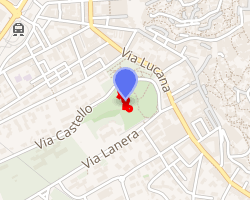Castello Tramontano
Castello Tramontano is a 16th century fortification in Matera.
| Castello Tramontano | |
|---|---|
| Southern Italy | |

| |
 Castello Tramontano | |
| Coordinates | 40°39′50″N 16°36′21″E |
| Site information | |
| Condition | Preserved |
| Site history | |
| Built | 16th century |
History
The castle is situated on a hill, called the lapel hill, above the historical centre of Matera.
In Aragonese style, the castle, with a central male and two lower side towers, one and the other round, scalloped and equipped with loops, was built from 1501 by Giovanni Carlo Tramontano, Count of Matera. The new king of Naples, Ferdinand II, had promised the Materrani not to give the city to any more feudal lords, after that this had already freed itself several times from the feudal yoke paying various ransoms in order to remain free city to autonomous regiment, that is directly dependent on the Crown. Instead the Count sets, which boasted claims against the royal treasury, asked and obtained the Matera County in 1496.
The Count soon became enfeebled to the materani because with the passage of time he was replenished with debts, in order to cope with which he taxed the population with heavy taxes. Thus began the construction of the castle, which was situated on a hill dominating the city, outside the city walls, with the purpose of "feudal" control of the surrounding lands rather than defense of the city itself.
It seems that then the construction should have included other defensive towers, one of which was found under the central Piazza Vittorio Veneto in Matera together with other underground environments. For the construction of the castle 25,000 ducats were spent and this weighed even more on the population.
It was thus that some citizens, tired of the continuous abuses, gathered hidden behind a rock, which since then was called "u pizzon' du mal consigghj", that is "the stone of bad council", and organized the assassination of the "tyrant" set. On December 29, 1514, the count, who had just left the Cathedral, was assassinated in a side street of the same, which was later eloquently called "Way of ransom".
The castle thus remained unfinished. Since 2008, he has been interested, together with the surrounding park, in restoration works still in progress. Some of these interventions are aimed at the recovery of the moat with the restoration of the tufa walls. The project is financed also thanks to the funds of the Game of the Lotto.
Bibliography
- Canino, Antonio (1980). Basilicata Calabria. Touring Editore. ISBN 88-365-0021-8.
- Matera: il Castello Tramontano. La Tipografica. 2010.
- Retrospettiva di un delitto: Giovan Carlo Tramontano e il castello di Matera. G. Barile. 2014.
See also
- City of Matera